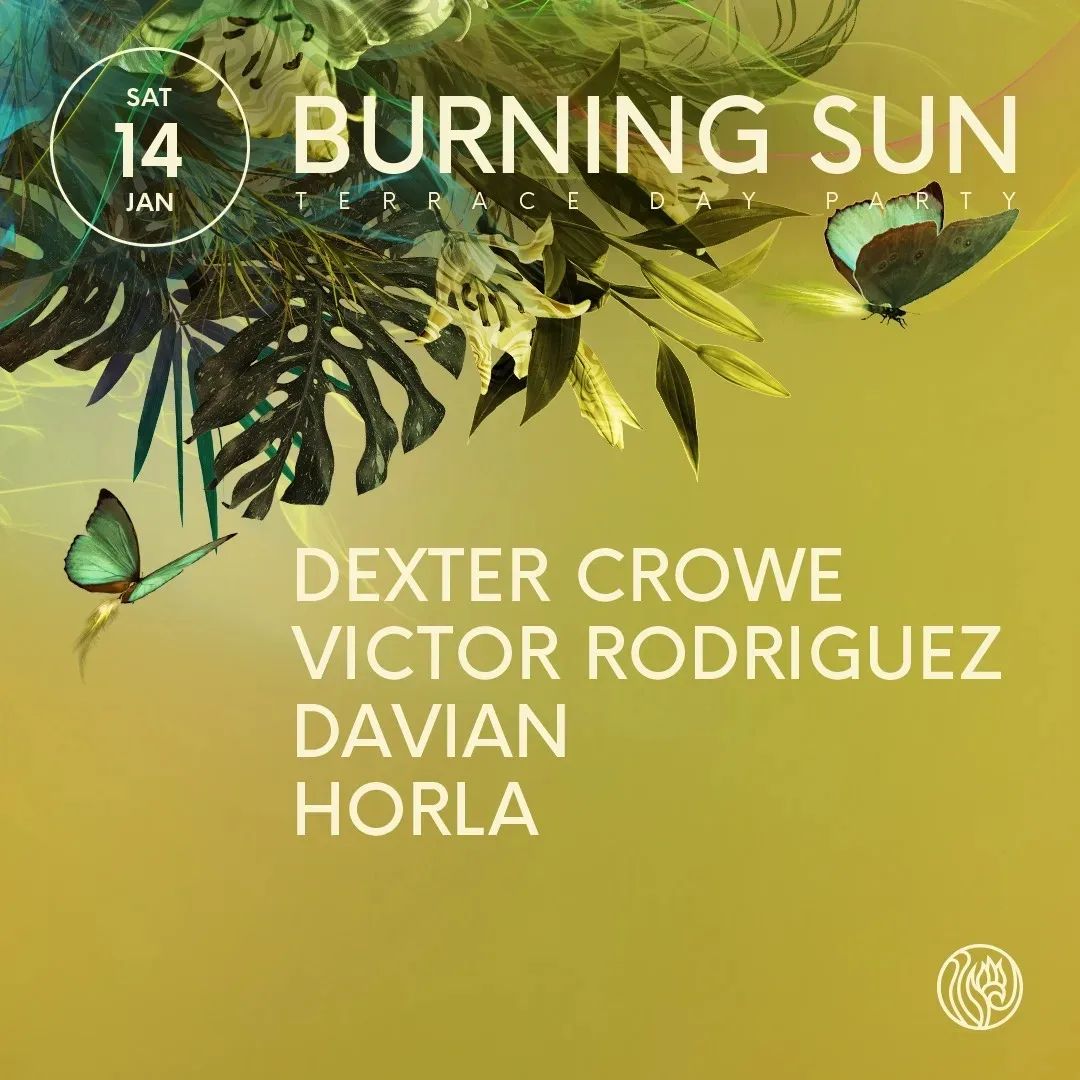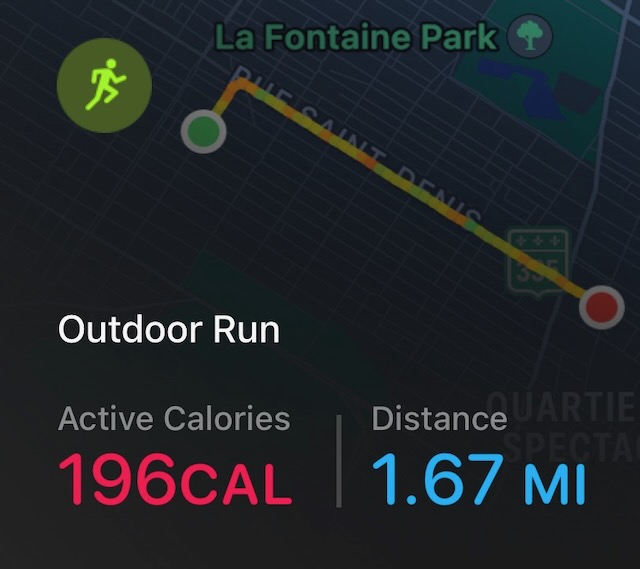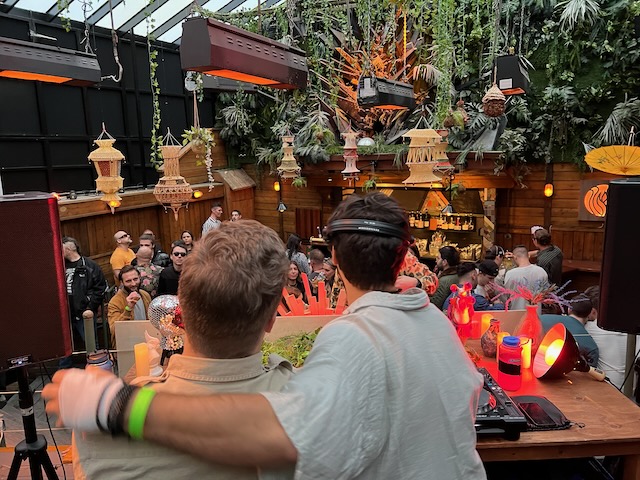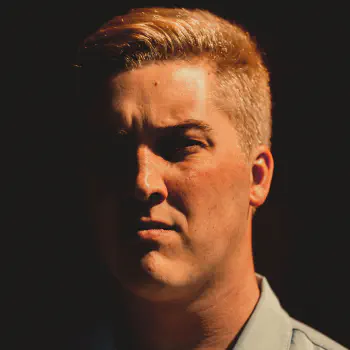Burning Sun (Horla, Davian, Victor Rodriguez, and Dexter Crowe)
Event Date: January 14th, 2023
Table of Contents
I attended a Burning Sun event for the first time this weekend, hosted by @floral_nights at Abreuvoir’s heated terrasse. The event gets an A+ for the friendly and beautiful crowd, excellent music, and the decorated venue. The title, “Burning Sun” was apt—it felt like I was transported back to summer (in the middle of the winter!).
In this review, I’ll discuss my experience, focusing on some of the music that stood out to me along with some of the DJ techniques I observed. You should know that I’m a music theorist by training, so this post will spend a lot of time going deep into some technical aspects of the music. I’ve embeded videos of all the music I reference, with links to all of the major streaming platforms so you can add the tracks to your own library. Feel free to jump ahead to read about the music played by Horla, Davian, Victor Rodriguez, or Dexter Crowe. The music I discuss worked really well in the setting—that is, it got everyone dancing hard. You should listen to these tracks.
Arrival
Burning Sun ran from 1:00-10:00pm,1 but my adventure started at 2:15pm when I realized that I had 45 minutes to get to Abreuvoir to pay the $25 ticket charge (instead of $35, which started after 3PM). How much is $10 worth? I decided to run from my apartment to Abreuvoir to make it before 3pm (about 1.5 miles). I arrived at 2:55pm with 5 minutes to spare! But this effort was in vain, because the line to buy tickets was long and and the 3pm deadline starts at the moment you arrive at the ticket booth. Was the extra $10 worth it? Yes! Let me tell you why.

Burning Sun Poster

My run to Burning Sun
The Crowd
Before I get into talking about the music and DJS, I should mention that I was frequently distracted in my research by the many beautiful people at the event. The crowd (ages ranged but were 25+) was wonderfully inclusive and gorgeous. The overall atmosphere was joyous and people were dancing as hard as they were smiling. The organizers have cultivated a non-predatory atmosphere that focuses first and foremost on the music. Is that why these events always sell out?

Horla
The night started with Horla on the decks. He played a more downtempo, organic-house set. As I arrived at 2:55pm, I missed most of his set, unfortunately, which started around 1pm. But from what little I heard, it was clear that Horla had good taste. Although he was the opener, I could imagine him playing later in the evening during peak hours. I’m excited to listen to his upcoming original release, which should be out soon.2 Horla deserves more words and I look forward to writing more about him in the future.
Davian
Davian picked off where Horla left off, with some organic and tropical sounding house. Many of the tracks he played combined typical house elements (e.g., well mixed kicks and bass with typical house drum patterns) with acoustic “tribal” sounding (for lack of a better word) instruments. Think wooden flutes, hand drums, and sounds that emphasize acoustic imperfections like overblow.3
For example, consider NonCitizens’s “Lost Trumpet in Space,” a track that Davian played around 5:20pm.4 One would be hard pressed to give this song a better title: it mixes acoustic claps, hand drums, wood sticks, a metallic shaker that is auto-panned in the stereo field, a round sequenced kick (as opposed to one played in live like much of the rest of the percussion) and, of course, a trumpet in space. It is the combination of acoustic, live instruments blended with sequenced and electronic sounds that typifies the “Tribal House” sound.
For another example, consider Moonalaya by Chambord (120bpm), the track that Davian used to close his set. Again, we hear hand drums, “tribal” and non-descript vocals layered over a round kick, and a sustained, heavily low-passed, saw-waveform synth patch (sound). This synth follows a 4-measure loop that changes chords every measure on the beat (listen at 2:24 during the break to hear it clearly with the filter opening).
Moonalaya is worth studying because the artist manages to sustain interest over a static 4-m. harmonic loop that sounds through almost the entire track.5 Chambord keeps our interest by adding additional layers and filtering pre-existing ones over the same harmonic progression. For instance, at minute 4:50—halfway into the track—Chambord adds another synth layer that pans through the stereo field and opens the cutoff filter on the backing 4-m. sustained synth.
Another layer enters the track at 6 minutes: at this point, a plucky arpeggiated sound arrives with a short attack that also follows the underlying 4-m. chord progression. The arpeggiated sound has a heavy auto-pan effect (as do many of the other layers in the track). Finally, at around the 7-minute mark, a low filtered almost-reese bass enters that seriously propels the track to its climax. Beatport classisfies this track as “Melodic House & Techno,” which, at least when it comes to “techno,” is a stretch. To me, it epitomizes “Tribal” and “Organic” house with a strong progressive element (where the “progressive” refers to the addition of additional timbres rather than progressive harmonies).
Chambord was the last track that Davian played—the end of his story (as he puts it). It was at this time that another wave of people entered the terrace. More people equated to more energy: the bells rang at the bar (for shots) and Davian ended his set on a high note. It was -10C outside, but the room was on fire.
Victor Rodriguez
After Davian, Victor Rodriguez took the booth and kicked up the heat even further. He opened his set strong with a groovy version of “Another Lonely Day” by James Cole (2022 release). This track seriously picked up the tempo for the night (recall we were once at 120bpm in Davian’s sets and we are now at 128bpm), but Victor gradually slowed it down back to 123–124bpm for the rest of his set. The most notable element in Cole’s track (watch it below) was the crash cymbal build that starts at 4:40. It’s an unusual way to make the build and it works really well instead of a more normative snare-roll build. Listen too how the artist layered in a kick with the crash cymbal for the build, which would have been too weak by itself (a snare-roll build doesn’t need the kick added because it has some low frequencies already). This track set the tone for the rest of Victor’s house-focused set.
The vocals for “Another Lonely Day” are popular: for another version, listen to Chico Flash’s (2021) rendition, which came out a year before Cole’s. I gave this earlier released track a listen and enjoyed it, so let me dissect it too. The middle of the track (2:07 in the linked, radio version) features an excellent breakdown with some organ-sounding chords that have serious swagger. At the end of the breakdown, a crash cymbal-build leads to the drop at 2:34 which begins with a funky 1-measure bass loop.6 Layered over this loop is another 4-measure pattern that consists of two jazzy chords that change each 2 measures. The drums consist of a nice big open hi-hat and a killer jacking-house groove. To top it all off, a saxaphone layer adds some stabs that create a call and response with the electric piano chords. If you need a classic house track reference, this one would be an excellent choice!
Another track that Victor played that really stood out to me (and everyone else on the dancefloor) was Mochakk’s “Da Fonk (feat Joni)”. My favorite moment in the track occurs at 2:40 when nearly all of the layers have left the mix. It is at this moment that Mochakk introduces a two chord piano anacrusis (pre-drop),7 which lands on the third harmony at the moment the drums re-enter (i.e., on the drop: the top of the chord moves A, F, E, with the bass moving A, F, A).8 It’s an incredibly effective moment and it’s no surprise that this musical idea returns later in the track to great effect once more (at 4:30). For me, this was one of my favorite tracks of the night, mostly because of this little piano riff. Whether everyone in attendance consciously was aware of it or not, it seems like they really enjoyed these moments too!
I didn’t stay to see the end of Victor’s set, unfortunately, because I had to get a Uniburger next door. But it is evident that he was very well recieved and I enjoyed what I saw of his well-curated set.
Dexter Crowe
I had high expectations for Dexter, as many had told me about his virtues before I saw him play. After watching him work, I see why he garners such high praise! He opened his set with Gaoulé Mizik’s “A Ka Titine (Detroit Swindle Edit)”, then played his own edit of Rammö & Ben Juno’s “Your Mess”. Mizik’s “A Ka Titine” served as a nice bridge that linked all of the organic and tribal house from earlier in the night to what would become Dexter’s groovy house set. It brings “traditional” sounding vocals, rich hand-drumming, and electronically sequenced drum elements (the kick) and bass.
I liked the opener, but I liked the second track even more. Rammö and Ben Juno’s “Your Mess” has a simple electro bass that sits extremely well in the mix (check out the 1-minute mark below). The bass, an octave leap (from Aflat-1 to Aflat-0) is as basic as it could be, but the timbre (a slightly squelchy, low-passed sound), rhythmic position, and placement in the mix creates an undeniable and addicting groove. As the track opens up, a rich house-sounding open hi-hat combines with a well chosen snare (3 minutes). Some vocal samples from two different people complete the sonic environment. It was an an excellent way to get his set started and it landed well in the room.
One of the many DJ skills I noticed that Dexter had was an acute sense of the beat and song structure. His movements were quick and precise, which contributed to clean FX and transitions. A lesser DJ could simply mix smoothly from one track to the next, but Dexter was able to create additional interest between his mix-ins by using tightening-loop repeats and other FX to create additional drops. It is evident that Dexter is also a producer, as this type of thinking was on display in his DJ set.
Another fun track Dexter played was Lex & Wood’s “Danza De Los Diablos.” The track features a 1-m. piano loop that sounds throughout the entire track. For much of the piece, the piano riff is bandpassed (from ~300Hz to 2kish) to sit further back in the mix, which makes room for the drums and prevents it from drawing too much attention. I liked the riff so much I had to transcribe its primary notes (below is the 1-m. loop). This track also features a ton of interesting ear candy throughout and vocal samples are used to great rhythmic effect. Give it a listen!

Danza De Los Diablos Piano Riff in Piano Role Notation
Concluding Thoughts
I could speak about more about the DJs and the excellent music they played, but this will have to be enough for this review. I had a great time at the Burning Sun event and I learned a lot (musically). And don’t worry, I love analyzing music—it doesn’t pull me out of the moment, it pushes me further into it! So if you see me taking notes at an event, you know I’m having a good time.
See you at the next event!
Footnotes
Pro-tip for Burning Sun events at Abreuvoir: arrive considerably before 3PM as everyone is trying to sneak in right before the increased ticket prices. Many restraunts and coffee shops are around the area if you need lunch or whatever before the event. Don’t make the same mistake I did. ↩︎
You’ll be able to find this release on Horla’s profile page ↩︎
Most of these sounds I’m referencing that create these effects were in the aerophone family (i.e., they make sound by vibrating a column of air), but there could have also been some string-sounds (i.e., chordophones). I’m by no means an instrument scholar, but the “imperfect” nature of older instruments seems to characterize well the “tribal” sound of “organic” and “tribal” house. ↩︎
This track would have been fitting for 4:20pm, which Davian nicely marked by showing the crowd the clock at this time. This was a nice gesture, as I think it’s valuable to collectively mark times together. ↩︎
If I were to be critical, I think Chambord should have added more harmonic interest as the loop gets a little stale over 9+ minutes (at least, for someone like me who cares about harmonic interest). Still, the clever interplay and progression of all the musical layers makes it work on the dance floor and that’s all that really matters. ↩︎
It seems that James Cole’s version was heavily influenced by Chico Flash’s version, as the crash cymbal build is in both. ↩︎
An “anacrusis” is musical material that occurs before the downbeat. Wikipedia’s article on the topic is okay if you want to read more on this idea. It is an essential concept for creating more impactful drops. ↩︎
Notice how the bass moves parallel with the top-voice at first, but on the last harmony, it moves back to it’s former position in contrary motion with the upper voice. The almost-independent nature of the two voices is called counterpoint. If you are interested in studying counterpoint, check out this link here. Note also that the final chord, a simple A minor harmony, feels like a landing point, but it doesn’t sound excessively static because the chordal fifth is in the top-most voice rather than the third (C) or first (A). ↩︎
Artist Profiles
About the Author
Thomas Posen @thomasposen
Thomas is a music scholar, pianist, and electronic composer-producer based in Montréal. He is passionate about Beethoven’s music, the history of music theory, and electronic dance music. You can listen to his music on SoundCloud and learn more about him on his personal website, thomasposen.com.









